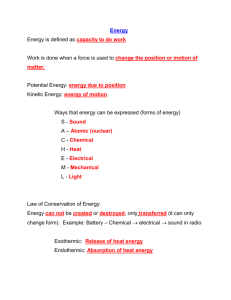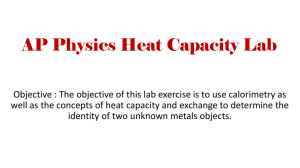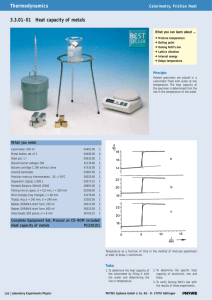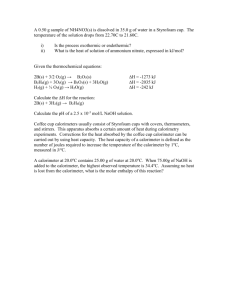Experiment 36 Determining Heat Capacity
advertisement
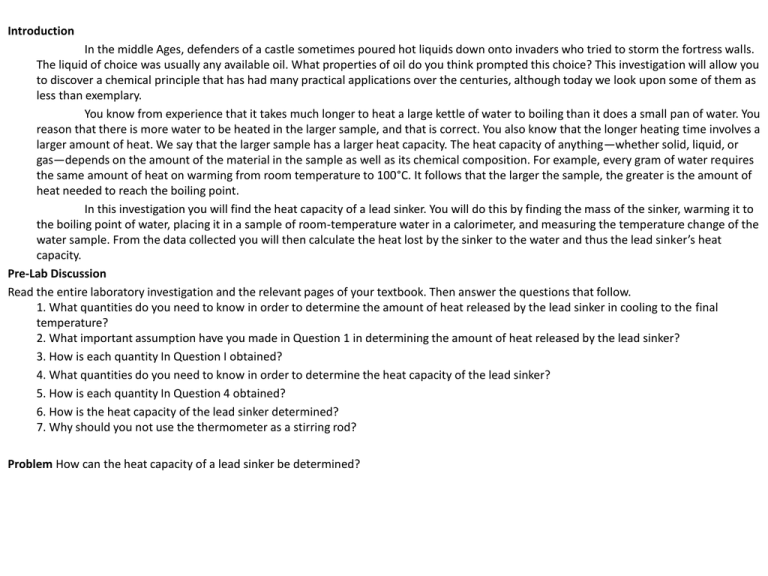
Introduction In the middle Ages, defenders of a castle sometimes poured hot liquids down onto invaders who tried to storm the fortress walls. The liquid of choice was usually any available oil. What properties of oil do you think prompted this choice? This investigation will allow you to discover a chemical principle that has had many practical applications over the centuries, although today we look upon some of them as less than exemplary. You know from experience that it takes much longer to heat a large kettle of water to boiling than it does a small pan of water. You reason that there is more water to be heated in the larger sample, and that is correct. You also know that the longer heating time involves a larger amount of heat. We say that the larger sample has a larger heat capacity. The heat capacity of anything—whether solid, liquid, or gas—depends on the amount of the material in the sample as well as its chemical composition. For example, every gram of water requires the same amount of heat on warming from room temperature to 100°C. It follows that the larger the sample, the greater is the amount of heat needed to reach the boiling point. In this investigation you will find the heat capacity of a lead sinker. You will do this by finding the mass of the sinker, warming it to the boiling point of water, placing it in a sample of room-temperature water in a calorimeter, and measuring the temperature change of the water sample. From the data collected you will then calculate the heat lost by the sinker to the water and thus the lead sinker’s heat capacity. Pre-Lab Discussion Read the entire laboratory investigation and the relevant pages of your textbook. Then answer the questions that follow. 1. What quantities do you need to know in order to determine the amount of heat released by the lead sinker in cooling to the final temperature? 2. What important assumption have you made in Question 1 in determining the amount of heat released by the lead sinker? 3. How is each quantity In Question I obtained? 4. What quantities do you need to know in order to determine the heat capacity of the lead sinker? 5. How is each quantity In Question 4 obtained? 6. How is the heat capacity of the lead sinker determined? 7. Why should you not use the thermometer as a stirring rod? Problem How can the heat capacity of a lead sinker be determined? Materials chemical splash goggles beakers, 600mL beakers, 400mL laboratory apron hot plate lead shot graduated cylinder, 100mL Laboratory balance 2 thermometers or temperature probes plastic foam calorimeter thermometer clamp test tube clamp ring stand • Safety Wear your goggles and tab apron at all times during the investigation. Use caution when working with the hot plate. Never touch it with ban skin. Note the caution and alert symbols here and with certain steps of the procedure. Refer to page xi for the specific precautions associate with each symbol. Procedure 1. Put on your goggles and lab apron. 2. Obtain approximately 50 g of lead shot from your instructor and find its mass to the nearest 0.01 g. Record the mass in the data table. 3. Place the lead shot into a test tube. 4. Place a plastic foam calorimeter inside a 600-mL beaker. 5. On a hot plate, begin to heat about 300 mL of water contained in a 400-mL beaker. Clamp the test tube containing the lead shot in the hot water bath. 6. Continue heating the beaker until the water has been boiling for at least 3 min. CAUTION: The hot plate and water are very hot. Avoid touching them with bare skin. Measure and record the temperature of the boiling water to the nearest 0.2°C. This will take approximately 20 min. 7. Place 100.0 mL of room-temperature water in the calorimeter. Record the temperature of the water to the nearest 0.2°C. Keep the thermometer in the calorimeter for the remainder of the investigation. 8. Carefully remove the test tube from the boiling water bath and pour the lead shot into the water In the calorimeter. 9. Gently stir the calorimeter water while continuously observing the temperature change. Record the maximum temperature to the nearest 0.2°C. 10. When the final temperature reading has been taken, return the shot to your instructor, Turn off the hot plate. Clean up your work area and wash your hands before leaving the laboratory. Procedure 1. Put on your goggles and lab apron. 2. Obtain approximately 50 g of lead shot from your instructor and find its mass to the nearest 0.01 g. Record the mass in the data table. 3. Place the lead shot into a test tube. 4. Place a plastic foam calorimeter inside a 600-mL beaker. 5. On a hot plate, begin to heat about 300 mL of water contained in a 400-mL beaker. Clamp the test tube containing the lead shot in the hot water bath. 6. Continue heating the beaker until the water has been boiling for at least 3 min. CAUTION: The hot plate and water are very hot. Avoid touching them with bare skin. Measure and record the temperature of the boiling water to the nearest 0.2°C. This will take approximately 20 min. 7. Place 100.0 mL of room-temperature water in the calorimeter. Record the temperature of the water to the nearest 0.2°C. Keep the thermometer in the calorimeter for the remainder of the investigation. 8. Carefully remove the test tube from the boiling water bath and pour the lead shot into the water In the calorimeter. 9. Gently stir the calorimeter water while continuously observing the temperature change. Record the maximum temperature to the nearest 0.2°C. 10. When the final temperature reading has been taken, return the shot to your instructor, Turn off the hot plate. Clean up your work area and wash your hands before leaving the laboratory. Procedure 1. Put on your goggles and lab apron. 2. Obtain approximately 50 g of lead shot from your instructor and find its mass to the nearest 0.01 g. Record the mass in the data table. 3. Place the lead shot into a test tube. 4. Place a plastic foam calorimeter inside a 600-mL beaker. 5. On a hot plate, begin to heat about 300 mL of water contained in a 400-mL beaker. Clamp the test tube containing the lead shot in the hot water bath. 6. Continue heating the beaker until the water has been boiling for at least 3 min. CAUTION: The hot plate and water are very hot. Avoid touching them with bare skin. Measure and record the temperature of the boiling water to the nearest 0.2°C. This will take approximately 20 min. 7. Place 100.0 mL of room-temperature water in the calorimeter. Record the temperature of the water to the nearest 0.2°C. Keep the thermometer in the calorimeter for the remainder of the investigation. 8. Carefully remove the test tube from the boiling water bath and pour the lead shot into the water In the calorimeter. 9. Gently stir the calorimeter water while continuously observing the temperature change. Record the maximum temperature to the nearest 0.2°C. 10. When the final temperature reading has been taken, return the shot to your instructor, Turn off the hot plate. Clean up your work area and wash your hands before leaving the laboratory. Procedure 1. Put on your goggles and lab apron. 2. Obtain approximately 50 g of lead shot from your instructor and find its mass to the nearest 0.01 g. Record the mass in the data table. 3. Place the lead shot into a test tube. 4. Place a plastic foam calorimeter inside a 600-mL beaker. 5. On a hot plate, begin to heat about 300 mL of water contained in a 400-mL beaker. Clamp the test tube containing the lead shot in the hot water bath. 6. Continue heating the beaker until the water has been boiling for at least 3 min. CAUTION: The hot plate and water are very hot. Avoid touching them with bare skin. Measure and record the temperature of the boiling water to the nearest 0.2°C. This will take approximately 20 min. 7. Place 100.0 mL of room-temperature water in the calorimeter. Record the temperature of the water to the nearest 0.2°C. Keep the thermometer in the calorimeter for the remainder of the investigation. 8. Carefully remove the test tube from the boiling water bath and pour the lead shot into the water In the calorimeter. 9. Gently stir the calorimeter water while continuously observing the temperature change. Record the maximum temperature to the nearest 0.2°C. 10. When the final temperature reading has been taken, return the shot to your instructor, Turn off the hot plate. Clean up your work area and wash your hands before leaving the laboratory. Procedure 1. Put on your goggles and lab apron. 2. Obtain approximately 50 g of lead shot from your instructor and find its mass to the nearest 0.01 g. Record the mass in the data table. 3. Place the lead shot into a test tube. 4. Place a plastic foam calorimeter inside a 600-mL beaker. 5. On a hot plate, begin to heat about 300 mL of water contained in a 400-mL beaker. Clamp the test tube containing the lead shot in the hot water bath. 6. Continue heating the beaker until the water has been boiling for at least 3 min. CAUTION: The hot plate and water are very hot. Avoid touching them with bare skin. Measure and record the temperature of the boiling water to the nearest 0.2°C. This will take approximately 20 min. 7. Place 100.0 mL of room-temperature water in the calorimeter. Record the temperature of the water to the nearest 0.2°C. Keep the thermometer in the calorimeter for the remainder of the investigation. 8. Carefully remove the test tube from the boiling water bath and pour the lead shot into the water In the calorimeter. 9. Gently stir the calorimeter water while continuously observing the temperature change. Record the maximum temperature to the nearest 0.2°C. 10. When the final temperature reading has been taken, return the shot to your instructor, Turn off the hot plate. Clean up your work area and wash your hands before leaving the laboratory. Procedure 1. Put on your goggles and lab apron. 2. Obtain approximately 50 g of lead shot from your instructor and find its mass to the nearest 0.01 g. Record the mass in the data table. 3. Place the lead shot into a test tube. 4. Place a plastic foam calorimeter inside a 600-mL beaker. 5. On a hot plate, begin to heat about 300 mL of water contained in a 400-mL beaker. Clamp the test tube containing the lead shot in the hot water bath. 6. Continue heating the beaker until the water has been boiling for at least 3 min. CAUTION: The hot plate and water are very hot. Avoid touching them with bare skin. Measure and record the temperature of the boiling water to the nearest 0.2°C. This will take approximately 20 min. 7. Place 100.0 mL of room-temperature water in the calorimeter. Record the temperature of the water to the nearest 0.2°C. Keep the thermometer in the calorimeter for the remainder of the investigation. 8. Carefully remove the test tube from the boiling water bath and pour the lead shot into the water In the calorimeter. 9. Gently stir the calorimeter water while continuously observing the temperature change. Record the maximum temperature to the nearest 0.2°C. 10. When the final temperature reading has been taken, return the shot to your instructor, Turn off the hot plate. Clean up your work area and wash your hands before leaving the laboratory. Procedure 1. Put on your goggles and lab apron. 2. Obtain approximately 50 g of lead shot from your instructor and find its mass to the nearest 0.01 g. Record the mass in the data table. 3. Place the lead shot into a test tube. 4. Place a plastic foam calorimeter inside a 600-mL beaker. 5. On a hot plate, begin to heat about 300 mL of water contained in a 400-mL beaker. Clamp the test tube containing the lead shot in the hot water bath. 6. Continue heating the beaker until the water has been boiling for at least 3 min. CAUTION: The hot plate and water are very hot. Avoid touching them with bare skin. Measure and record the temperature of the boiling water to the nearest 0.2°C. This will take approximately 20 min. 7. Place 100.0 mL of room-temperature water in the calorimeter. Record the temperature of the water to the nearest 0.2°C. Keep the thermometer in the calorimeter for the remainder of the investigation. 8. Carefully remove the test tube from the boiling water bath and pour the lead shot into the water In the calorimeter. 9. Gently stir the calorimeter water while continuously observing the temperature change. Record the maximum temperature to the nearest 0.2°C. 10. When the final temperature reading has been taken, return the shot to your instructor, Turn off the hot plate. Clean up your work area and wash your hands before leaving the laboratory. Observations DATA TABLE Mass of lead shot Mass of room temperature water Initial temperature of water in calorimeter Final temperature of water in calorimeter Temperature of boiling water Calculations 1. Determine the change in temperature of the water in the calorimeter. 2. Determine the heat absorbed by the 100.0 mL of water in the calorimeter in warming to the final temperature. 3. Determine the change in temperature of the lead sinker in cooling to its final temperature. 4. Calculate the amount of heat released by the lead sinker for each one-degree Celsius change in temperature. This Is the heat capacity of the sinker, Critical Thinking: Analysis and Conclusions 1. What scientific law accounts for the assumption that the heat gained by the water in the calorimeter Is equal to the heat lost by the lead sinker? (Applying concepts) 2. If you had a lead sample that was double the mass of the sinker you used in the investigation, what would be the heat capacity of the heevier sample? Give the reason for your answer, (Making comparisons) 3 What is the relationship between the specific heat of a substance and the heat capacity of a sample of that substance? (Applying concepts)_ 4. Given the mass of your lead sample. calculate c, the specific heat of lead. (Applying concepts) 5. Determine the percent error for the specific heat calculated in I Question4lftheacceptedvalueforthespeclbcheatofteadis 0.159 J/g.°C. (Applying concepts) 6. Predict whether or not the values for the heat capacity of the sinkers used by your classmates will be the same as the value you obtained for your sinker. (Making predictions) Critical Thinking Applications 1. The specific heat of most oils Is about 2 J/g.C. compared to a value of 415 j/g.°C for water. Why do you now think oil, rather than water, was the liquid of choke used by castle defenders against invading forces? (Making comparisons) 2. A disc of wax has several hot metal samples placed on It. The samples are of different metals. They are all at the same temperature and have the same mass and contact area with the wax. How will the heat capacity of each metal sample affect the rate at which it melts the wax? (Making predictions)
